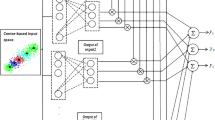Abstract
Mixture of experts (ME) is a modular neural network architecture for supervised learning. This paper illustrates the use of ME network structure to guide diagnosing of breast cancer. Expectation-maximization (EM) algorithm was used for training the ME so that the learning process is decoupled in a manner that fits well with the modular structure. Diagnosis tasks are among the most interesting activities in which to implement intelligent systems. Specifically, diagnosis is an attempt to accurately forecast the outcome of a specific situation, using as input information obtained from a concrete set of variables that potentially describe the situation. The ME network structure was implemented for breast cancer diagnosis using the attributes of each record in the Wisconsin breast cancer database. To improve diagnostic accuracy, the outputs of expert networks were combined by a gating network simultaneously trained in order to stochastically select the expert that is performing the best at solving the problem. For the Wisconsin breast cancer diagnosis problem, the obtained total classification accuracy by the ME network structure was 98.85%. The ME network structure achieved accuracy rates which were higher than that of the stand-alone neural network models.
Similar content being viewed by others
References
Jacobs, R. A., Jordan, M. I., Nowlan, S. J., and Hinton, G. E., Adaptive mixtures of local experts. Neural Comput. 3(1):79–87, 1991.
Chen, K., Xu, L., and Chi, H., Improved learning algorithms for mixture of experts in multiclass classification. Neural Netw. 12(9):1229–1252, 1999.
Hong, X., and Harris, C. J., A mixture of experts network structure construction algorithm for modelling and control. Appl. Intell. 16(1):59–69, 2002.
Jordan, M. I., and Jacobs, R. A., Hierarchical mixture of experts and the EM algorithm. Neural Comput. 6(2):181–214, 1994.
Mangiameli, P., and West, D., An improved neural classification network for the two-group problem. Comput. Oper. Res. 26(5):443–460, 1999.
Hu, Y. H., Palreddy, S., and Tompkins, W. J., A patient-adaptable ECG beat classifier using a mixture of experts approach. IEEE Trans. Biomed. Eng. 44(9):891–900, 1997.
Güler, İ., and Übeyli, E. D., A mixture of experts network structure for modelling Doppler ultrasound blood flow signals. Comput. Biol. Med. 35(7):565–582, 2005.
Baxt, W. G., Use of an artificial neural network for data analysis in clinical decision making: The diagnosis of acute coronary occlusion. Neural Comput. 2:480–489, 1990.
Miller, A. S., Blott, B. H., and Hames, T. K., Review of neural network applications in medical imaging and signal processing. Med. Biol. Eng. Comput. 30:449–464, 1992.
West, D., and West, V., Model selection for a medical diagnostic decision support system: A breast cancer detection case. Artif. Intell. Med. 20(3):183–204, 2000.
Setiono, R., Extracting rules from pruned neural networks for breast cancer diagnosis. Artif. Intell. Med. 8(1):37–51, 1996.
Setiono, R., Generating concise and accurate classification rules for breast cancer diagnosis. Artif. Intell. Med. 18(3):205–219, 2000.
Wolberg, W. H., and Mangasarian, O. L., Multisurface method of pattern separation for medical diagnosis applied to breast cytology. In Proceedings of the National Academy of Sciences, Vol. 87, Washington, pp. 9193–9196, December 1990.
Jerez-Aragones, J. M., Gomez-Ruiz, J. A., Ramos-Jimenez, G., Munoz-Perez, J., and Alba-Conejo, E., A combined neural network and decision trees model for prognosis of breast cancer relapse. Artif. Intell. Med. 27(1):45–63, 2003.
Basheer, I. A., and Hajmeer, M., Artificial neural networks: Fundamentals, computing, design, and application. J. Microbiol. Methods 43(1):3–31, 2000.
Chaudhuri, B. B., and Bhattacharya, U., Efficient training and improved performance of multilayer perceptron in pattern classification. Neurocomputing 34:11–27, 2000.
Haykin, S., Neural Networks: A Comprehensive Foundation, MacMillan, New York, 1994.
Zweig, M. H., and Campbell, G., Receiver-operating characteristic (ROC) plots: A fundamental evaluation tool in clinical medicine. Clin. Chem. 39(4):561–577, 1993.
Author information
Authors and Affiliations
Corresponding author
Rights and permissions
About this article
Cite this article
Übeyli, E.D. A Mixture of Experts Network Structure for Breast Cancer Diagnosis. J Med Syst 29, 569–579 (2005). https://doi.org/10.1007/s10916-005-6112-6
Issue Date:
DOI: https://doi.org/10.1007/s10916-005-6112-6




